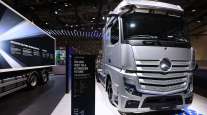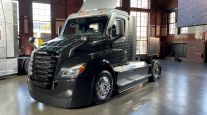Managing Editor, Features and Multimedia
Daimler Plans Automated Truck Research Center in Portland
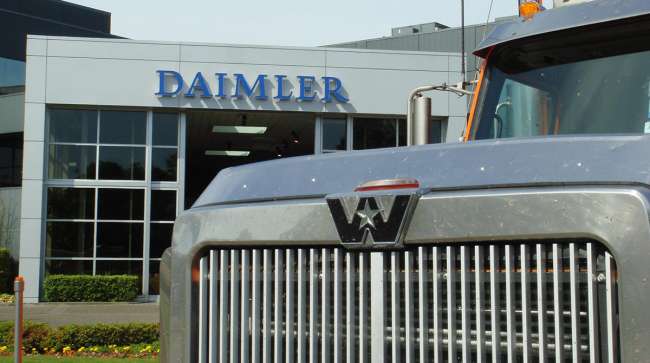
PORTLAND, Ore. — Daimler Trucks is opening an automated truck research and development center here at its North American headquarters to help pave the way for highly automated commercial vehicles.
The manufacturer of Freightliner and Western Star trucks also outlined its vision for the advance of automation in trucking and showcased its next wave of driver-assist systems here on June 6 at the company’s capital market and technology day.
During the event, the company demonstrated its prototype two-truck platooning system with automated steering capabilities at the Portland International Raceway.
ALL-ELECTRIC MODELS UNVEILED: Production begins in 2021
'IT'S UP TO THE SHAREHOLDERS:' Daum lukewarm on splitting into separate car/truck companies
Those types of so-called Level 2 systems, which add automated steering functions but continue to rely on the driver to operate and monitor the vehicle, “will come to market soon,” said Peter Vaughan Schmidt, head of global strategy for Daimler Trucks
From there, Daimler Trucks will focus on building toward Level 4 automation, where the vehicle can operate itself under certain conditions with no driver input and no expectation that the driver would need to intervene.
On that journey, the company’s priority will be safety, Vaughan Schmidt said. “Whatever we do, it must be 100% reliable. There is no 99.9% solution.”
Highly automated trucks also would need to gain public acceptance as well as the confidence of fleet customers, Vaughan Schmidt said. He also pointed to the legal framework for operation and liability as another important factor.
Whatever we do, it must be 100% reliable. There is no 99.9% solution.
Daimler's Peter Vaughan Schmidt
Ultimately, Level 4 automated trucks could begin to relieve the trucking industry’s persistent shortage of qualified drivers by making the job more attractive, he said, but it is unrealistic to expect automation to completely solve the driver shortage any time soon.

In our debut episode of RoadSigns, we ask: What does the move toward autonomy mean for the truck driver? Hear a snippet from Alex Rodrigues, CEO of Embark, above, and get the full program by going to RoadSigns.TTNews.com.
“Drivers will still be in high demand for the foreseeable future,” Vaughan Schmidt said, adding that fully autonomous — or driverless — trucks still have a long way to go before they will be market ready.
Like several other developers of automated driving systems, Daimler Trucks said it is not interested in Level 3 systems, which would enable autonomous driving but would still depend on the driver to intervene as a fallback.
To support Daimler’s move toward higher levels of automation, engineers at the new automated truck research center in Portland will test and validate software, onboard sensors, machine learning and vehicle design while collaborating with existing Daimler locations in Stuttgart, Germany, and Bangalore, India.
This work will build on previous automated driving research conducted across Daimler’s divisions, including its Mercedes-Benz passenger car business.
The company said its efforts to develop highly automated driving technology will involve vehicle road testing over millions of miles around the globe and advanced simulation.
One test vehicle on display at the event was a “data collection” truck outfitted with an extensive of array of different onboard sensors — lidar, radar, cameras and ultrasonic — that could eventually support Level 4 automation.
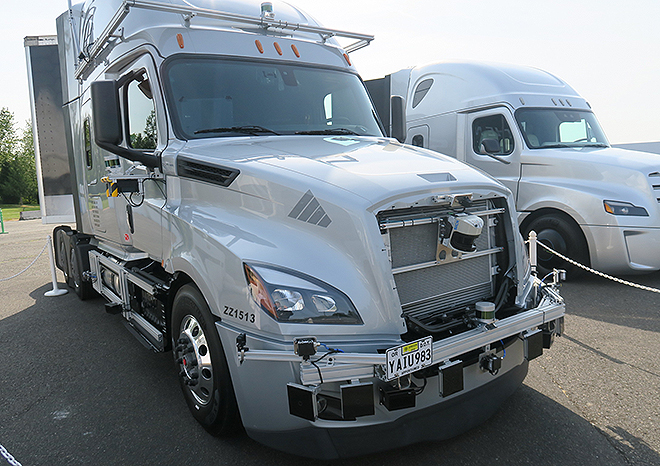
DTNA is using this “data collection” truck to test and validate various types of onboard sensors that could be used in automated driving systems. (Seth Clevenger/Transport Topics)
Derek Rotz, director of advanced engineering for DTNA, said the information captured by this test truck will help the company’s engineers determine which sensors are necessary, how many are needed and where they should be located on the vehicle to eliminate any blind spots.
Daimler Trucks also highlighted how automation could improve efficiency.
A pair of Freightliner tractors took to the track to demonstrate DTNA’s two-truck platooning technology.
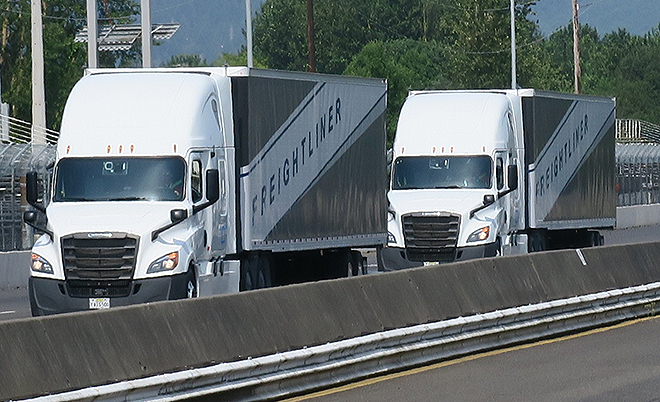
A pair of Freightliner trucks travel in a tight formation during a platooning demonstration at the Portland International Raceway. (Seth Clevenger/Transport Topics)
The system, which the company described as “truck pairing,” uses vehicle-to-vehicle communications to coordinate braking activity between the two trucks, enabling the second truck to travel at a closer-than-usual following distance that reduces aerodynamic drag and boosts fuel economy. In this case, the following distance was 15 meters.
The pair of trucks performed two safety maneuvers on the track.
In the first demonstration, a passenger car cut in between the two platooning trucks. The second truck automatically responded by slowing down to create a safer following distance.
Daimler Trucks platooning demonstration at Portland International Raceway. The platooning tech responds to a passenger car cutting in. @DaimlerTrucksNA @Daimler_CV pic.twitter.com/GKEiADDBc8 — Seth Clevenger (@SethClevenger) June 6, 2018
“To make the product a reality, we have to think about all these different use cases it might encounter and design for that,” Rotz said.
In the second demo, the paired trucks both automatically applied the brakes when the platoon approached a stationary object in the road. Through V2V communications, the trailing truck can automatically brake in less than three-tenths of a second, much faster than a human would react, the company said.



